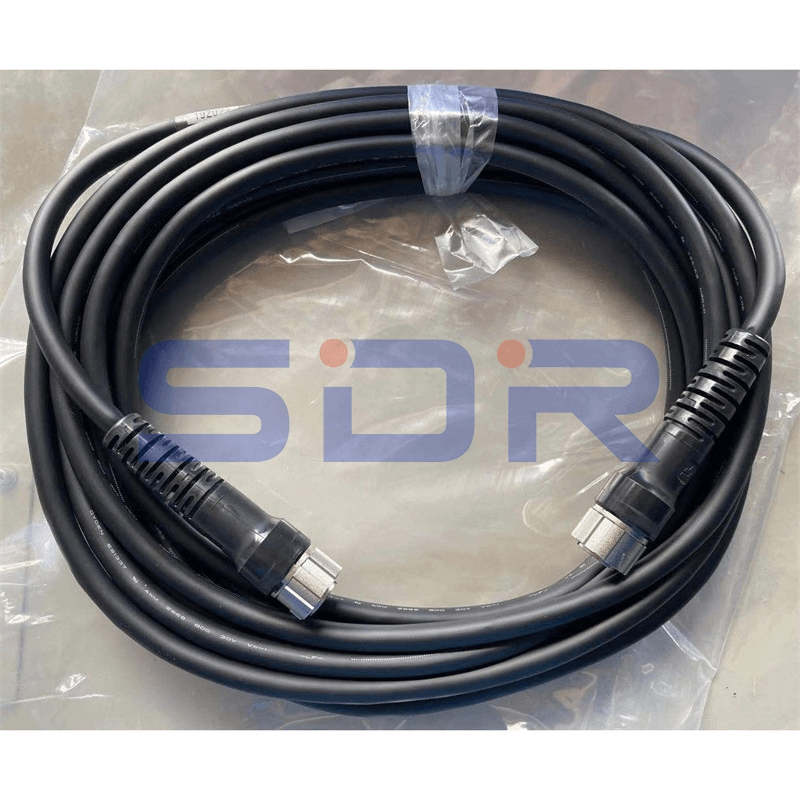The HB1371456-1 New Yaskawa Teach Pendant Cable is a specialized 8-meter industrial-grade connection cable designed to interface between a Yaskawa robot controller and its corresponding handheld teach pendant. Engineered to meet rigorous industrial standards, its primary function is to facilitate reliable, high-speed data communication and power delivery for precise robot programming and operational control. A key characteristic is its extended 8-meter (approximately 26.25-foot) length, which provides technicians and operators with significant flexibility and mobility during setup, programming, and troubleshooting tasks without necessitating the relocation of the often bulky controller cabinet. This length is meticulously calculated to minimize signal degradation, a common issue with longer cables, ensuring data integrity over the entire distance.

Constructed for durability, the cable features premium shielded twisted-pair (STP) copper wiring with a specific impedance rating, typically around 100Ω, to effectively combat electromagnetic interference (EMI) and radio-frequency interference (RFI) prevalent in noisy manufacturing environments. This shielding ensures signal-to-noise ratios are maintained, guaranteeing the accurate transmission of critical motion commands and feedback data. The connectors are industrial-grade, often featuring gold-plated contacts to reduce electrical resistance and prevent corrosion, ensuring a stable and low-voltage drop connection. The outer jacket is made from a high-quality, oil-resistant PVC or PUR material, offering high tensile strength (often exceeding XXX N/mm²) and flexibility, with a wide operating temperature range from -10°C to +70°C, making it suitable for harsh conditions.
The Hb1371456-1 cable is an indispensable component within industrial automation, specifically tailored for systems utilizing Yaskawa Motoman robots. Its primary application is in manufacturing sectors where Yaskawa robots are deployed.
Automotive Manufacturing: In automotive assembly lines, this cable is used to connect teach pendants to controllers for programming robots tasked with precise operations like welding, with accuracy within fractions of a millimeter; painting, requiring smooth and consistent motion paths; and material handling of heavy components. The 8m length allows an operator to safely program and observe the robot from an optimal vantage point outside the robot's work envelope.
Electronics and Semiconductor Production: Within cleanrooms and ESD-protected areas, robots assemble delicate circuit boards and handle silicon wafers. The cable’s shielded design is critical here to prevent EMI from disrupting sensitive low-voltage signals from the pendant, ensuring programming commands for micro-adjustments are executed without error.
Pharmaceutical and Food & Beverage Packaging: In these hygienic and often wash-down environments, the cable’s robust jacket material resists degradation from exposure to cleaning chemicals, moisture, and steam. Technicians use the pendant to program robots for precise picking, placing, and packaging tasks on high-speed production lines.
Metal Fabrication and Casting: In foundries and welding shops, robots perform cutting, grinding, and arc welding. The cable must withstand elevated ambient temperatures, airborne metallic dust, and spatter. Its durable construction protects the internal conductors, ensuring reliable communication for programming complex welding paths and handling sequences.
General Material Handling and Logistics: In warehouses and distribution centers, Yaskawa robots palletize and depalletize goods. The extended cable length is crucial for operators to program and troubleshoot robots that service large work cells or multiple conveyor lines from a ·central control point.
Proper maintenance is essential to maximize the service life and ensure the reliable performance of the HB1371456-1 Teach Pendant Cable. Adhering to a disciplined care routine can prevent costly downtime and potential damage to the robot controller or pendant.
1. Routine Inspection:Perform a visual inspection before each use or on a scheduled weekly basis. Examine the entire length of the cable for any signs of physical damage, such as cuts, abrasions, cracking, or flattening of the outer jacket. Pay close attention to areas near the connectors and any points where the cable may repeatedly bend or contact sharp edges. Inspect the connectors for bent or broken pins, corrosion, or accumulation of dirt and debris. Any compromise in the jacket integrity can expose the internal shielding and wires to moisture and contaminants, leading to signal failure.
2. Proper Handling and Usage:The most critical aspect of cable care is managing its bend radius. Avoid sharp bends, kinking, or twisting the cable during use. The minimum bend radius is typically specified by Yaskawa (e.g., no less than 5 times the cable's diameter); exceeding this can stress and break the internal wires. Never use the cable to pull the teach pendant or allow it to be run over by equipment like forklifts. When connecting or disconnecting the cable, always grip the connector body firmly—never pull on the cable itself, as this can strain the internal termination points and lead to wire breakage.
3. Cleaning:If the cable becomes dirty, clean it with a soft cloth lightly dampened with a mild, non-abrasive soap solution or isopropyl alcohol. Ensure the cloth is well-wrung to prevent excess fluid from entering the connector interfaces. Do not use strong solvents, acids, or alkaline cleaners, as they can degrade the plasticizers in the cable jacket, making it brittle and prone to cracking. After wiping, dry the cable thoroughly with a clean, dry cloth before reinstalling it.
4. Storage and Transportation:When not in use, the cable should be coiled loosely in a figure-eight pattern or in a large-diameter loop to prevent introducing twist and strain. Avoid tight, circular coiling which can cause permanent set memory and weaken the internal conductors. Store the coiled cable in a clean, dry, and temperature-controlled environment, away from direct sunlight, ozone sources, and chemicals. Use a dedicated storage bin or hang it on a large hook to avoid tangling and physical damage from other equipment.
5. Connector Care:Protect the connector pins from contamination and physical damage. When disconnected, immediately fit protective caps onto both ends of the cable. Before mating the connectors, visually verify that they are clean, dry, and aligned correctly. Do not force a connection, as misalignment can easily bend the delicate pins, resulting in poor contact and intermittent faults.
By implementing these maintenance practices, the HB1371456-1 cable will maintain its electrical and mechanical properties, providing a stable and long-lasting connection for critical robot programming and operational tasks.